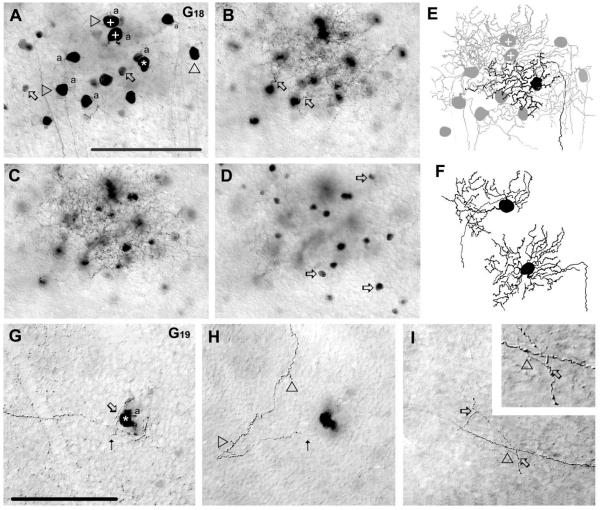Figure 11.
Morphology and tracer coupling patterns of the G18 and G19 ganglion cell subtypes. A–D: Photomicrographs showing soma/dendritic morphology and coupling pattern of a G18 cell (asterisk). This G18 cell displays homologous coupling to an array of ganglion cell somata (arrowheads) and heterologous coupling to amacrine cells (arrows) in the GCL (A). The plus (+) signs mark the somata of the coupled ganglion cells drawn in panel F. Arrows in panel B point to emerging dendritic stalks of coupled ganglion cells in the proximal IPL, whereas panel C displays more distally located dendritic branches of labeled G18 cells. The labeled G18 cell also displays heterologous coupling to amacrine cells with somata that lay in the INL (arrows) (D). E: Camera-lucida drawing of the G18 ganglion cell shown in panels A–D showing the dendritic architecture of the injected (black) and coupled ganglion cells (gray); the plus signs mark coupled ganglion cells drawn in panel F. Note the extensive overlap of dendritic arbors of the injected and coupled G18 cells. F: Camera-lucida drawings of two coupled ganglion cells that share their soma/dendritic morphologies with the injected G18 cell. G–I: Photomicrographs showing a G19 cell (asterisk). The arrow points to the site where a dendrite emerges, whereas dotted arrow indicates where the dendrite leaves the plane of focus (G) and where it comes back into view in a more distal plane of the IPL (H). Arrowheads in panel H point to small dendritic side branches. Panel I shows the axon of this G19 cell, which shows clear sprouting (arrowhead), with daughter branches that enter the IPL and show two additional branch points (arrows). Inset enlarges the site of the primary (arrowhead) and one of the secondary (arrows) branch points. This G19 cell shows no evidence of tracer coupling. a, axon. Scale bars = 100 μm.

